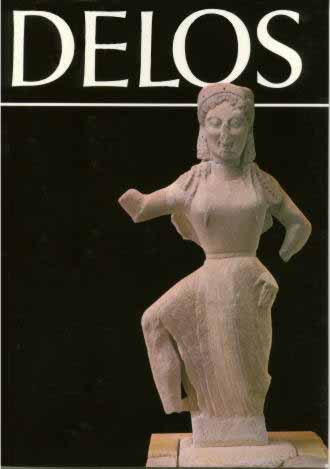A Statue from the island of Delos
Delos is virtually at the center of the Cyclades, the half-way point on the journey between mainland Greece and Ionia, the islands of Chios, Samos, and Rhodes to the east, and Crete to the south. Its geographical position made it inevitable that Delos should become a trading center early on, and develop steadily into one of the most important in the eastern Mediterranean.
To a large extent Delos owed its development to the fact that it was the birthplace of Apollo, which made it a holy place. The tale is well-known. As the time for the birth of Leto's child by Zeus approached, Hera's jealousy of her rival knew no bounds; she hunted Leto all over the world so that the mother could find no place in which to bring forth her child. Leto eventually came to a barren and isolated rock which, scarcely rising above the surface of the sea was always changing position. When Leto promised that the child to be born would never leave the place where he first saw light and that over it he would shed lustre and shower riches the island ceased to float. Leto lost her fear and stayed there.
Close to the wheel-shaped lake and in sight of Mount Cynthus Leto gave birth to the most handsome of immortals. The land, bathed in radiant light and clothed with flowers, rejoiced as the new-born Phoebus, his golden locks flung back,
played his beloved lyre and practised with his bow. Henceforward, the island Asteria, known til then as A-delos, the invisible, because of its perpetual wandering, was called Delos, that is to say the 'clearly seen'. Legend even has it that it was held fast by adamantine chains.
The earliest traces of settlement on Delos reach back to the third millennium B. C. Its first inhabitants probably belonged to one of the prehistoric peoples of the Aegean whom Thucydides called Carians. Remains of their circular hut-dwellings have been found on Mount Cynthus the safest part of the island. However, for the next thousand years, traces of human settlement are absent from Delos as from the other Cycladic islands.
The sacred isle of Apollo first flourished in the second half of the second mellenium B. C. (1580-1200 B.C.), the Mycenean Period. The unchallenged sea power of Minos which removed all threat of piracy made it possible for the town to spread over the relatively fertile plain; a settlement, whose buildings were imposing for the time developed around the harbor.
About 1100 B. C. the Mycenean world collapsed before the ionian peoples who flooded over mainland Greece and settled amongst the islands, and on the eastern coast of the Aegean. The Odyssey and the Homeric Hymn to Apollo, written at the latest, by 700 B. C., mention Delos as a well-known Ionian religious center. Naturally the boats which brought pilgrims to the sanctuary also carried merchandise so that Delos' development as a commercial port was ensured. It is, however, important to note that the Ionian amphictiony constituted the particular declaration of worship at a common center which brought together shared aims and interests.


